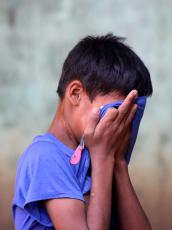Pandemic-Related Stress Among Latina Mothers Linked to Greater Child Externalizing Behaviors
By Chase J. Boyer, Elisa Ugarte, Andrea C. Buhler-Wassmann and Leah C. Hibel, University of California, Davis
Systemic oppression renders the Latinx community particularly vulnerable to the economic and health risks of the COVID-19 pandemic, with psychological consequences for parents and their children. In a recent study, we sought to understand how financial cutbacks and fears of contracting COVID-19 contributed to children’s externalizing behaviors due to increases in maternal stress among low-income Latina mothers. Data were collected from mothers approximately once a month across the first 10 months of the COVID-19 pandemic.
We found that children exhibited more externalizing behaviors among Latinx families who engaged in more financial cutbacks but only for mothers who reported higher stress. In addition, periodic spikes in Latina mothers’ fears of contracting COVID-19 coincided withperiodic spikes in stress, which in turn predicted periodic spikes in child externalizing behaviors.
Our findings suggest that providing economic support for vulnerable families would help promote resilience to future crises among low-income Latinx families.
Key Facts
- Children exhibited more externalizing behaviors among Latinx families that engaged in more pandemic-related financial cutbacks as a function of maternal stress.
- Periodic spikes in Latinx mothers’ fears of contracting COVID-19 contributed to periodic spikes in stress, which predicted periodic spikes in child externalizing behaviors.
- Providing economic support for vulnerable families would help promote resilience to future crises among low-income Latinx families.
Background
The COVID-19 pandemic has contributed to high levels of stress from social isolation, fear of infection, and economic hardship, especially for lower income and minoritized families.[1] Latinx families have faced the brunt of these hardships with higher rates of unemployment and morbidity and mortality caused by COVID-19, compared to non-Latinx White individuals.[2] The family stress model (FSM) describes how stressors such as these have the potential to initiate a cascade of problems for family well-being.[3] Specifically, stress jeopardizes parents’ psychological functioning, undermining the quality of the parent–child relationship and increasing punitive and controlling parenting. Family stress in early childhood due to economic hardship can contribute to the emergence of externalizing behaviors, such as acting out or arguing. Over time, greater incidence of externalizing behaviors can lead to a range of socioemotional issues including delinquency, substance use, and co-occurring internalizing disorders with the possibility of continuing across generations.[4]
Hispanics/Latinxs are hospitalized for COVID-19 at a rate four times higher than non-Hispanic Whites.[5] Our preliminary analyses in the Latinx community revealed that worries about contracting the virus contributed to mothers’ overall stress.[6] Thus, for many Latinx families, the threat of illness collided with a reasonable fear of experiencing sustained economic hardship. In our study, we aimed to examine the impact of contextual stressors of the pandemic (economic hardship, fear of the virus) on maternal functioning (stress) and how these jointly contributed to child externalizing behaviors.[7]
Exploring Links Between Maternal Stress and Child Externalizing Behaviors
Between March 20, 2020 and January 31, 2021, we surveyed 73 Latina mothers living in California’s Sacramento and Yolo Counties via phone call. Mothers were called on average eight times across the first 10 months of the pandemic. On average, mothers were 25.41 years old and the children they reported on were 35.98 months old. Most mothers (85 percent) were married or in a romantic relationship and had one child in the home (55 percent). We asked them a range of questions regarding how worried they were about themselves, their child(ren), family members, their partner, and other people in the home contracting the virus. We also asked them about the financial cutbacks they had made, about the general stress they were experiencing (for example, how often they felt unable to control the important things in their life), and about their children’s externalizing behaviors, such as disobedience and arguing.
Having collected these data, we examined both the within- and between-person impacts of worry surrounding contracting the virus and the economic consequences of the pandemic on maternal stress and child externalizing behaviors. Between-person analyses test the association between average levels of worry and stress and child externalizing behaviors. Within-person analyses, on the other hand, examine how changes or spikes in a mother’s fear of illness and general stress impact changes/spikes in her child’s externalizing behaviors. Together, these analyses reveal how different levels of stress impact families as well as how changes in stress reverberate across a family.
Cutbacks Contributed to Increases in Mothers’ Reports of Child Externalizing Behaviors
Overall, children’s externalizing behaviors, maternal stress, and financial cutbacks varied from call to call. On the other hand, fear of illness remained relatively stable across persons and had only minor changes between calls.
Our results indicate that financial cutbacks contributed to increases in mothers’ reports of child externalizing behaviors by increasing maternal stress between-families overall (see Figure 1). In other words, the economic fallout from the pandemic may have initiated a process in which stress driven by financial cutbacks and or fear of illness spilled over into these families’ dynamics that contributed to an increase in their child’s externalizing behaviors.

Figure 1: On average, greater economic cutbacks lead to more stress from mothers, which lead to more externalizing behaviors from their children.
Images by Freepik (wallet), syarifahbrit on Freepik (woman), Adobe Stock (children)
Interestingly, the within-person analyses revealed spikes in mothers’ fears surrounding contracting COVID-19, and not financial cutbacks, had a significant impact on maternal stress and child externalizing behaviors (see Figure 2). Thus, fluctuations in mothers’ fears about her or her family becoming infected with the virus, and not in financial cutbacks, spurred fluctuations in her stress. Further, mothers’ spikes in stress contributed to more child externalizing behaviors, but did not explain the connection between periodic increases in fear of illness and child externalizing. This suggests that worry about contracting the virus may impact these mothers’ stress without spilling over into childrens’ behaviors. We hypothesize that maternal stress impacted child behaviors through changes in parent-child interactions, however, this was not explicitly examined in the study model.

Figure 2: Children engaged in more externalizing behaviors during periods when mothers were more stressed than usual.
Image by pikisuperstar on Freepik
Periods of greater financial cutbacks for families did not contribute to greater stress among mothers or more frequent than usual child externalizing behaviors. Thus, many families may have been resilient to the harmful downstream effects of economic hardship on family stress processes, suggesting some sort of buffering process. Previous research with Mexican origin families has found that periods of financial stress can increase family cohesion and buffer against the effects of stress, but that process was not explored in this study.
Increase Support for Low-Income Families to Limit Impact of Future Crises
Structural disparities in economic mobility and health outcomes made Latinx families particularly vulnerable to the hardships brought about by the COVID-19 pandemic. Throughout the pandemic, federal and state aid provided support to families who were struggling to make ends meet, yet Latinx families experienced fewer improvements in economic conditions compared to non-Latinx White families, suggesting that this support was not enough to reduce family stress processes among vulnerable Latinx families.
Many of the families surveyed in our study had at least one essential worker in the home, had limited paid sick leave, and were less likely to be in occupations that allowed them to work from home. Each day these families were employed in situations that increased the risk of illness, placed stress upon mothers. This stress was associated with greater reports of their children’s behavior problems. Had these parents been guaranteed better paid sick leave, the periods during which virus cases were increasing may not have created the same levels of stress in mothers—stress that spilled over into their family relationships. Greater economic support for vulnerable families in periods of increased societal stress, along with greater protections for workers with limited sick leave and schedule flexibility, would likely help to limit the impact of future crises on children in low-income families.
Chase J. Boyer, Elisa Ugarte, and Andrea C. Buhler-Wassmann are PhD students at UC Davis. Leah C. Hibel is a professor of human development and family studies at UC Davis.
References
1. Brown, S. M., Doom, J. R., Lechuga-Peña, S., Watamura, S. E., & Koppels, T. (2020). Stress and parenting during the global COVID-19 pandemic. Child Abuse & Neglect, 110(Pt 2), Article 104699. https://doi.org/10.1016/j.chiabu.2020.104699
2. Tai, D. B. G., Shah, A., Doubeni, C. A., Sia, I. G., & Wieland, M. L. (2021). The disproportionate impact of COVID-19 on racial and ethnic minorities in the United States. Clinical Infectious Diseases, 72(4), 703– 706. https://doi.org/10.1093/cid/ciaa815
3. Conger, R. D., Ge, X., Elder, G. H., Jr., Lorenz, F. O., & Simons, R. L. (1994). Economic stress, coercive family process, and developmental problems of adolescents. Child Development, 65(2), 541– 561. https://doi.org/10.2307/1131401
4. Shi, Q., Ettekal, I., Deutz, M. H. F., & Woltering, S. (2020). Trajectories of pure and co-occurring internalizing and externalizing problems from early childhood to adolescence: Associations with early childhood individual and contextual antecedents. Developmental Psychology, 56(10), 1906– 1918. https://doi.org/10.1037/dev0001095
5. Oliver, S. (2020). U.S. COVID-19 epidemiology [PowerPoint slides]. Centers for Disease Control. https://www.cdc.gov/vaccines/acip/meetings/downloads/slides-2020-06/COVID-03-Oliver-508.pdf
6. Hibel, L. C., Boyer, C. J., Buhler-Wassmann, A. C., & Shaw, B. J. (2021). The psychological and economic toll of the COVID-19 pandemic on Latina mothers in primarily low-income essential worker families. Traumatology, 27(1), 40– 47. https://doi.org/10.1037/trm0000293
7. Boyer, C. J., Ugarte, E., Buhler-Wassmann, A. C., & Hibel, L. C. (2022). Latina mothers navigating COVID-19: Within- and between-family stress processes over time. Family Relations. https://doi.org/10.1111/fare.12748










